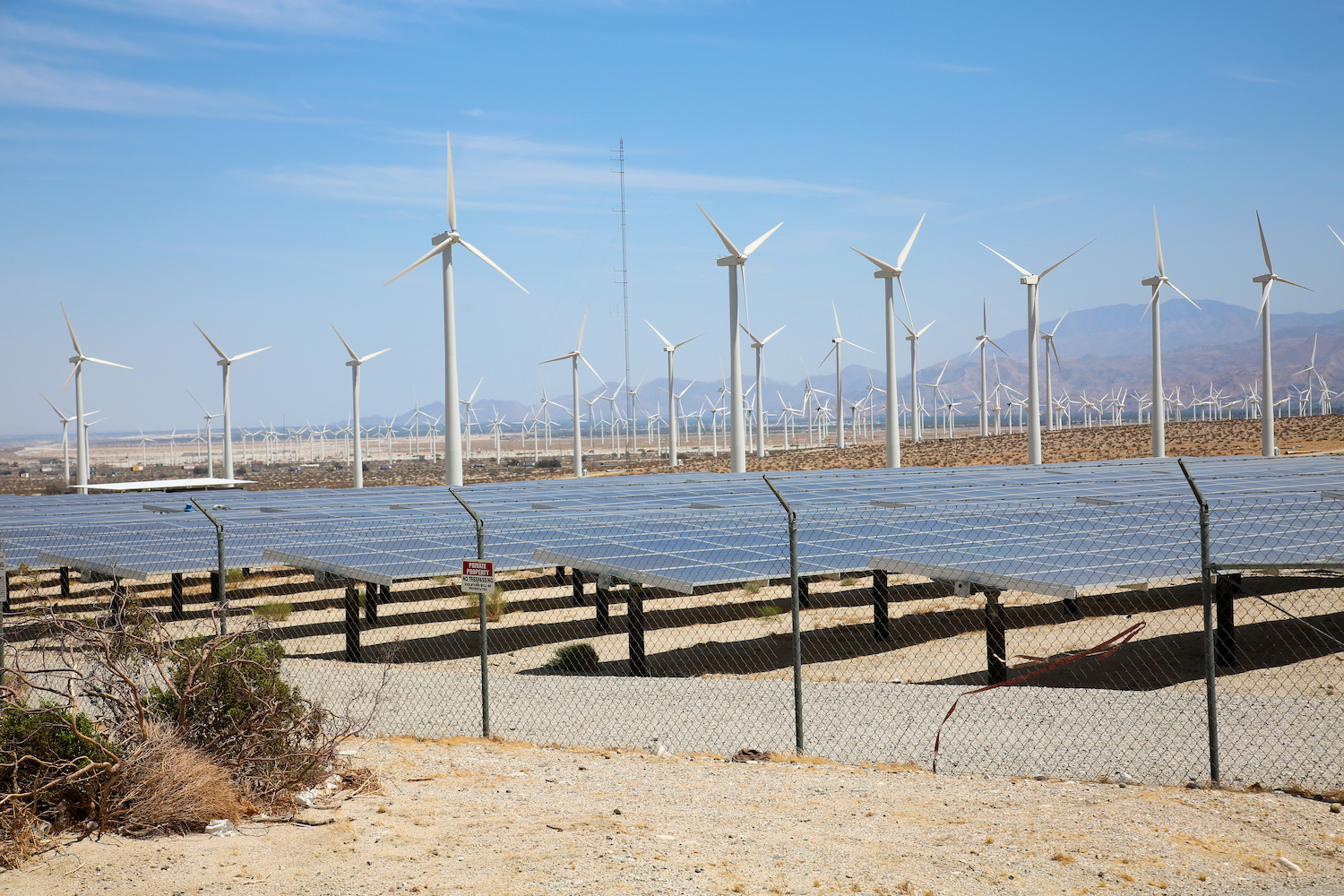Editor’s note: ImpactAlpha has partnered with HIP Investor to highlight upcoming bond issues with social and/or environmental significance. Disclaimer: Nothing in this post or on ImpactAlpha.com shall constitute an offer to sell or solicitation of an offer to buy bonds.
- CUSIP Bond identifier: 13013JCS3
- Issuer: California Community Choice Financing Authority (CCCFA)
- Impact entity rated by HIP: Clean Power Alliance of Southern California
- Muni Sector: Electric Utilities
- Closing date: 06/15/2023
- Bond amount: $ 958,290,000
- Coupon: 5.5%
- HIP impact rating : 64 (on a 100 point scale) = “net positive”
- Opportunity zones: 282 equaling 1,141,693 citizens in Los Angeles and Ventura Counties.
Southern California Green Bond
Earlier this month, California Community Choice Financing Authority (CCCFA) issued nearly $1 billion in bond debt to finance the acquisition of clean energy – including geothermal and solar-plus-storage – by the Clean Power Alliance of Southern California (CPA). The projects could impact approximately three million of South California residents.
By using the proceeds to finance electricity from renewable energy, and having a clear process for project evaluation and selection, as well as the management of the proceeds and reporting, the muni bond complies with the Green Bond Principles (GBP) established by the International Capital Market Association (ICMA) for the designation of the bond as a green bond.
The green bond principles are voluntary process guidelines aimed to provide issuers with guidance on the key elements involved in launching a green bond.
Community choice
Community Choice Aggregation (CCA) is a local not-for-profit organization that helps communities aggregate their electricity load in order to purchase clean energy and develop projects or programs for the residents and businesses of the community. CCAs are currently authorized in 10 states – 8 states that are generally pro-ESG like California, Illinois, Maryland, Massachusetts, New Jersey, New York, Rhode Island, and Virginia, and two states that are anti-ESG, like Ohio and New Hampshire.
CCAs were enabled in California in the Assembly Bill – AB 117 passed in 2002, following the California Energy Crisis of the early 2000s. The AB 117 allows the creation of CCAs and extends to the California Public Utilities Commission (CPUC) provisions that allow them to permit agencies to purchase and sell electricity on behalf of residents within their service areas. Once a CCA is established in a particular jurisdiction, all the utility customers in that jurisdiction are automatically enrolled in the CCA, if they do not want to be enrolled they have to take action to opt-out. Currently, there are 25 CCAs serving more than 11 million residents across California, with a participation rate ranging from 87% to 98%. Thus, only 2% to 13% of Californians in a jurisdiction with a CCA choose to opt out of this approach.
In 2021, four CCAs – the Central Coast Community Energy, the East Bay Community Energy, the Marin Clean Energy and Silicon Valley Clean Energy – formed a joint power authority: the California Community Choice Financing Authority (CCCFA). The joint power authority can help members save up to 10% or more on power purchases agreements, helping increase the amount and reduce the cost of clean energy on the California grid, combating climate change and increasing available funding for local programs. The CCCFA aims to reduce the cost of power purchases by undertaking the financing or refinancing of energy prepayment with tax-advantaged bonds.
One type of tax-advantaged bond issued by the CCCFA is a clean energy project revenue bond – a type of wholesale electricity prepayment that involves three key parties: (1) a municipal bond issuer, (2) a tax exempt public electricity supplier and (3) a taxable energy supplier. The municipal bond issuer is responsible for issuing tax exempt bonds to finance a prepayment of energy; the taxable energy supplier uses the proceeds of the bond to provide a discount to the tax exempt public electricity supplier on the purchase of power based on the difference between the taxable and tax exempt rate. This bond discount has ranged from 8 to 12 percent in the past. The three parties enter a long term energy supply agreement for clean electricity sources like solar, wind, geothermal and hydropower.
Tax exempt prepayment bonds have been used in the US since the early 1990s to lock-in the price of energy. In 2003, the U.S. Treasury issued final regulations regarding prepayments financed with Tax-Exempt Bonds permitting interest exclusion if at least 90% of the natural gas or electricity is furnished to retail customers in the service area of the municipal utility. Municipal tax exempt prepayment bonds have been used mainly to purchase natural gas.
In 2021, Black Belt Energy, an Alabama natural gas supply arm, issued a nearly $1.5 Billion bond for prepaid natural gas, and for the last 30 years over 100 prepayment transactions have been completed in the US, worth over $50 billion, with over 95% of them for natural gas. The California Community Choice Financing Authority (CCCFA) is using that same structure to reduce the cost of clean energy in California.
The first clean energy project revenue bond issued by the CCCFA generated $1.5 billion in proceeds. And in 2021, the CCCFA issued the first municipal Clean Energy Project Revenue Bonds worth over $2 Billion.
The latest clean energy project revenue bonds issued by the CCCFA is to the benefit of Clean Power Alliance of Southern California (CPA). The nearly $1 billion bond issuance is expected to lower costs of renewable energy procurement of the CPA by an average of $8.3 million per year during the first eight years period of the bond, an approximately $66.7 million reduction.
During the initial delivery period, Clean Power Alliance expects to receive approximately 5.9 million megawatt hours (“MwH”) of electricity, this clean electricity should avoid approximately 767 million pounds or 383,500 tons of greenhouse gas emissions while powering more than 194,000 Southern California homes per year.
HIP impact analysis
In 2017, the biggest Community Choice Aggregation in California, Clean Power Alliance (CPA) was launched. Clean Power Alliance of Southern California was established by Los Angeles County, with the cities of Rolling Hills Estate and South Pasadena as an administrator of a CCA program and a California Joint Powers Authority. In early 2018, 31 communities across Los Angeles and Ventura Counties joined the agency. Today, CPA is the fourth largest electricity provider in California and serves more than three million residents and businesses via one million customer accounts. CPA offers three rate plans:
- Lean Power with 40% of clean energy from a mix of renewable and zero-carbon hydropower, the cheapest option;
- Clean Power with 50% renewable energy; and
- 100% green power with 100% renewable energy from wind, solar and geothermal sources, the most expensive option.
Each city in the Clean Power Alliance jurisdiction has chosen a default option and residents and businesses in that community are automatically enrolled in that option. But utility customers can opt out or change their rate option anytime.
HIP evaluates the impact of over 1700 electric utilities across the country. The HIP rating for electric utilities is based on 15 material metrics aggregated into five key pillars – Health, Wealth, Earth, Equality and Trust – and include: dynamic pricing (percentage of customers enrolled in dynamic pricing), power mix of renewables versus fossil, air emissions related to fossil fuels, GHG emissions intensities, smart metering (percentage of total energy saved by using advanced metering infrastructure) and reliability (total time without power for each customer, excluding major events). Those metrics provide a clear picture of how the energy utility provides the citizens cleaner, more reliable electricity while being environmentally efficient.
Among HIP’s muni bond sector averages, the lowest-average rated is electric utilities, which are primarily owned or operated by cities, counties, states, regions, and nonprofits. The HIP Rating average for Electric Utilities is 45.2, whereas the overall rating of the Clean Power Alliance Green Bond is 64.6 (on a 100 point scale), and above-50 connotes “net positive” impact.
The CPA performs well above its peers overall, it also performs well on the Earth (59.8 pillar rating, vs 33.6 for the sector) and Health pillars (79.7 pillar rating, vs 44.4 for the sector). The CPA achieves an exceptionally high score of 85.8 for the trust pillar. One major performance driver is power reliability (total time without power for each customer, excluding major events).
When compared to the HIP universe of Electric Utilities, the CPA outperforms the customer weighted average by 37%. Thus, the CPA achieves more successful and reliable results while maintaining an emphasis on clean energy usage.
Alignment with the Global Goals
In addition to the analysis of the entity impact across the five HIP Pillars, the performance of the entity impact is linked to the UN Sustainable Development Goals SDG, through the HIP Sustainable Development Goal (SDG) Ratings. The HIP SDG ratings capture the degree to which the performance of the impact entity is aligned with the UN SDGs. HIP mapped more than 200 sector specific metrics to each of the 17 SDGs, weighted based on their relationship to the underlying targets for each SDG. For the utilities sector, the 15 HIP metrics are linked to 11 out of the 17 SDGs. Among the 11 UN SDGs that the performance of CPA is aligned to, it achieved a net positive score for 10 of 11. Selected SDG Ratings for CPA are:
CPA Leading on:
- SDG 7: Affordable and Clean Energy (60 of 100)
- SDG 11: Sustainable Cities and Communities (60 of 100)
- SDG 13: Climate action (56 of 100)
CPA Lagging on:
- SDG 8: Decent work and economic growth (42 of 100)
Scaling climate action
The core mission of this bond is to lower the cost of procurement of renewable energy, but there can be additional positive ripple effects from this muni bond. Among those effects we have:
- Leading more people to adopt a cleaner source of energy in Southern California : Clean Power Alliance currently serves more than three million people and offers them three different energy plans. By lowering the cost of renewable energy procurement, this bond can make clean energy more affordable and accessible to Southern California residents.
- Helping achieve the climate targets of the state of California: Many states have set ambitious targets to reach net zero. California passed the AB 32 Global Warming Solutions Act in 2006, and ten years later passed the Senate Bill 32 to strengthen its goal for greenhouse gas emissions to 40% below 1990 levels by 2030. This bond also plans to contribute to achieving the target of the 100 percent Clean Energy Act of 2018, Senate Bill 100 (SB 100 de León), energy legislation that requires the state of California to procure 60% of all electricity from renewable sources by 2030 and 100% from carbon-free sources by 2045.
- Helping achieve the climate target of the country: Achieving the climate targets is not only a state issue, but it is also a national one. Fossil fuels have dominated the U.S. energy mix for more than 100 years. Meanwhile, fossil fuels use is the largest source of US greenhouse gas emissions, accounting for 73% of U.S. human-caused greenhouse gas emissions in 2020. The mix has changed over time but renewable energy counted for only 12 percent of the energy consumption in 2021. That same year, President Biden set the 2030 Greenhouse Gas Pollution Reduction Target aimed at creating good-paying union jobs and pursuing U.S. leadership in clean energy technologies.
- Reducing pollution and saving lives: In 2017, The Lancet Commission on pollution and health reported that 9 million deaths per year are caused by diseases from toxic exposures in the environment, that is 20 times more than all wars. The updated report published in 2022 showed little improvement. Fossil Fuels combustion accounts for most of the Airborne nitrogen pollution that affects not only the quality of the air we breathe, but also the land and the water. Shifting from fossil fuels to cleaner sources of energy is not only an energy concern, but also a public health concern. Through the proceeds of this Bond, CPA will contribute to a less polluted environment, saving lives.
“Net positive” for planet and people
The US Energy Information Administration (EIA) projects U.S. energy consumption to grow through 2050, driven by economic growth; thus if more energy is required, and CO2 emissions need to be reduced, we need more investment in clean energy in order to fulfill that demand. With a HIP rating of 64.6 (on a 100 point scale), the Clean Power Alliance of Southern California uses prepayment bonds to lower the cost of procuring renewable energy.
CPA is a Community Choice Aggregation (CCA), which gives more control to local communities over their electricity sources, and allows them to receive more green energy than what is offered by the traditional electric utility. After five years of operation, CPA has a participation rate of 96% and more than 619,000 households, representing approximately one million of residents who have opted in for the 100% green power plan, even though it can be more costly. This shows a growing demand for clean energy and a need to make it even more affordable.
This green bond aims to lower the costs of renewable energy procurement in order to fulfill that demand, but it can also lead more people to adopt a cleaner source of energy in Southern California, can help achieve the climate targets of the state of California, while helping lower the level of pollution. This municipal bond is an example of how clean electricity can become more accessible and more affordable – by using the same instrument that has been used for decades to prepay for natural gas, a fossil fuel.
Rose Fadjia Joseph is an ESG impact investing analyst at HIP Investor Ratings LLC.
HIP Investor Inc. is a state-registered investment adviser in several jurisdictions, and HIP Investor Ratings LLC is an impact-ratings firm evaluating impact and ESG on 123,000 municipal entities, 250,000 muni-bond issuances, and 12,000 corporates for equities and bonds. HIP Impact Ratings are for your information and education – and are not intended to be investment recommendations. Past performance is not indicative of future results. All investments are risky and could lose value. Please consult your investment professionals to evaluate if any investment is appropriate for you, your goals, and your risk-return-impact profile.











